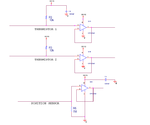shemo
Advanced Member level 4

I have this circuit diagram.
Thermistor1, themistor2, and position sensor.
A few questions.
1)Why thermistor1 pulled up to 5V? versus position sensor which pulled down using 1M resistor?
2)Why thermistor1 has a cap from 5V to GND and thermistor1 doesn't?
3)Because the output doesn't have a resistor load, and direct feedback from negative of opamp to output so the gain is 1?